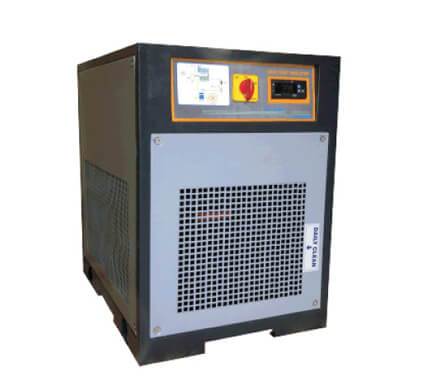The major need of the industries when it comes to the air dryers is the consistent and reliable supply of the compressed air but making sure the air is completely dry is the major challenge. Air compressor manufacturers in India say that the air that comes from the atmosphere contains moisture and its concentration increases gradually as it is compressed. When the compressed air becomes saturated, it attracts more foreign and dust particles getting contaminated quickly. There are various industries where this can lead to heavy production losses and can prove to be a major setback for the industries like the food industries where even a little bit of moisture in the air could contaminate the whole packaging of edibles and can lead to life-death situations. This is where the need of the air dryers arises and oil-free air compressor manufacturers recommend the use of either Refrigerated or Desiccant dryers and we will give you a quick overview on both.
Refrigerated air dryers

Refrigerated air dryers are normally appropriate for general-purpose compressed air applications, with pressure dew points ranging from 35 to 40 degrees Fahrenheit (PDP). Other drying technologies are often substantially more expensive. Refrigerated dryers cool compressed air and remove moisture using a refrigeration compressor and heat exchange. Refrigerated dryers are divided into two categories. Cycling is the more energy-efficient alternative and is often utilised for higher flows and where the flow rate fluctuates from shift to shift. The VSD refrigerated dryer, also known as a cycling drier, cycles on and off to supply the right PDP at varied flow rates. A non-cycling kind is the other, less expensive choice.
Non-cycling dryers are always on and run at the same load for the duration of their use. The contrast between the two is comparable to how your home refrigerator operates. Because you only use it when you need it, it “cycles” on and off as needed. You now have a “non-cycling” refrigerator if you leave the door open all the time. Before entering the air dyer, both types of dryers should have a coalescing pre-filter to remove large amounts of water droplets and oil mist.
Desiccant Air dryers
When your application demands very dry compressed air or the compressed air supply runs in cold settings, desiccant compressed air dryers are often used. Desiccant dryers can reach dew points as low as -100 degrees Fahrenheit. A desiccant air dryer may only be required in select facilities for specific applications and procedures. For example, an auto body business may just require a refrigerated air dryer for tools and general air usage, but the paint booth will benefit from highly clean and dry air. The desiccant in a twin towered desiccant dryer gathers moisture throughout the programmed cycle and then purges, releasing it to the atmosphere.The other tower is purging and renewing while the first is drying. Because the purge cycle of this sort of dryer uses a portion of the dried compressed air, you must ensure that you have enough compressed air to meet both your demand and the purge need.
Desiccant dryers come in a variety of styles, including non-heated, heated purge, and blower purge. To cleanse the off-line tower, more energy-efficient desiccant dryers will employ warm ambient air. Additional energy savings can be realised by connecting a PDP monitor to the dryer controller, which will decide when to switch the towers to begin the spent tower regeneration cycle. In most circumstances, the additional cost of a blower purge dryer will be soon offset by the compressed air system’s energy savings.



